Strategic Analysis of Emirates Airline in 2017: A Management Report
VerifiedAdded on 2022/08/10
|9
|2652
|292
Report
AI Summary
This report provides a comprehensive strategic analysis of Emirates Airline in 2017. It begins by examining the external forces influencing the airline's strategy, utilizing PESTEL and Porter's Five Forces models to assess the political, economic, socio-cultural, technological, environmental, and legal factors, as well as the competitive dynamics of the industry. The analysis delves into Emirates' internal resources and capabilities, highlighting its skilled workforce, focus on customer experience, and core competencies. The report then explores the business-level strategies employed by Emirates, including cost leadership and differentiation, while also addressing the challenges the airline faces, such as adapting to changing customer needs and government policies. The effectiveness of Emirates' leadership is also discussed, emphasizing the leadership styles and strategies adopted by key figures in the company. The report concludes by summarizing the key findings and insights into Emirates' strategic management approach.
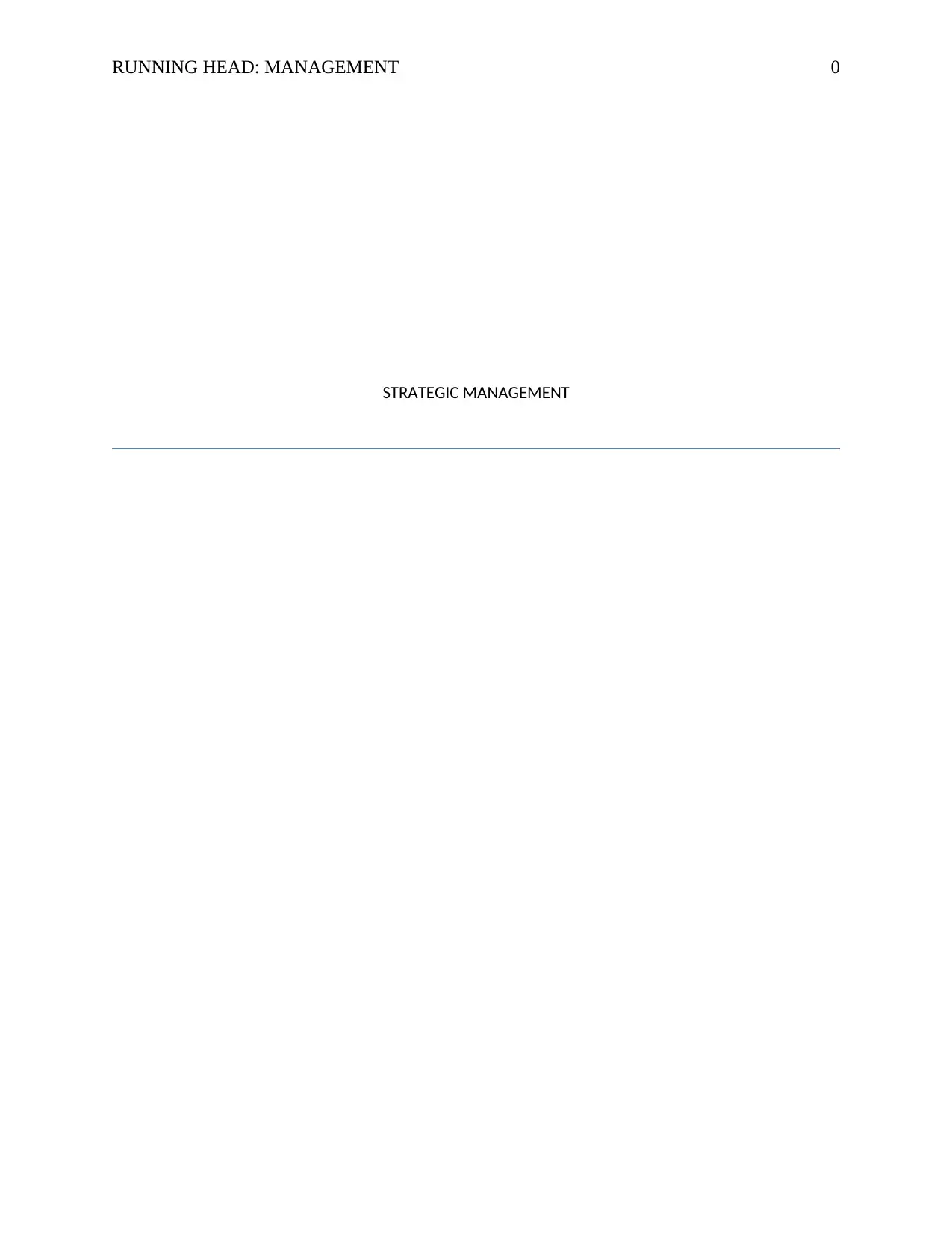
RUNNING HEAD: MANAGEMENT 0
STRATEGIC MANAGEMENT
STRATEGIC MANAGEMENT
Paraphrase This Document
Need a fresh take? Get an instant paraphrase of this document with our AI Paraphraser
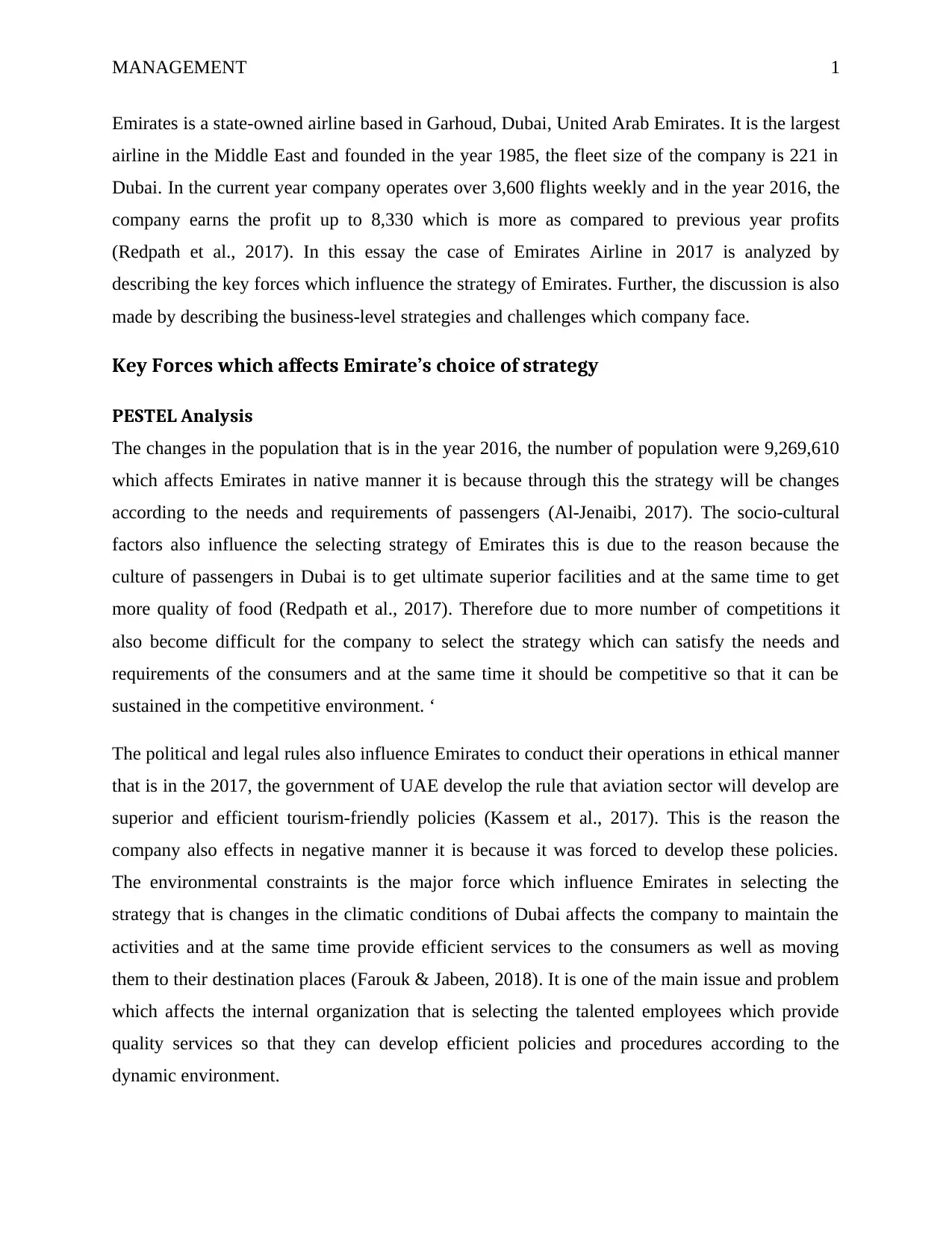
MANAGEMENT 1
Emirates is a state-owned airline based in Garhoud, Dubai, United Arab Emirates. It is the largest
airline in the Middle East and founded in the year 1985, the fleet size of the company is 221 in
Dubai. In the current year company operates over 3,600 flights weekly and in the year 2016, the
company earns the profit up to 8,330 which is more as compared to previous year profits
(Redpath et al., 2017). In this essay the case of Emirates Airline in 2017 is analyzed by
describing the key forces which influence the strategy of Emirates. Further, the discussion is also
made by describing the business-level strategies and challenges which company face.
Key Forces which affects Emirate’s choice of strategy
PESTEL Analysis
The changes in the population that is in the year 2016, the number of population were 9,269,610
which affects Emirates in native manner it is because through this the strategy will be changes
according to the needs and requirements of passengers (Al-Jenaibi, 2017). The socio-cultural
factors also influence the selecting strategy of Emirates this is due to the reason because the
culture of passengers in Dubai is to get ultimate superior facilities and at the same time to get
more quality of food (Redpath et al., 2017). Therefore due to more number of competitions it
also become difficult for the company to select the strategy which can satisfy the needs and
requirements of the consumers and at the same time it should be competitive so that it can be
sustained in the competitive environment. ‘
The political and legal rules also influence Emirates to conduct their operations in ethical manner
that is in the 2017, the government of UAE develop the rule that aviation sector will develop are
superior and efficient tourism-friendly policies (Kassem et al., 2017). This is the reason the
company also effects in negative manner it is because it was forced to develop these policies.
The environmental constraints is the major force which influence Emirates in selecting the
strategy that is changes in the climatic conditions of Dubai affects the company to maintain the
activities and at the same time provide efficient services to the consumers as well as moving
them to their destination places (Farouk & Jabeen, 2018). It is one of the main issue and problem
which affects the internal organization that is selecting the talented employees which provide
quality services so that they can develop efficient policies and procedures according to the
dynamic environment.
Emirates is a state-owned airline based in Garhoud, Dubai, United Arab Emirates. It is the largest
airline in the Middle East and founded in the year 1985, the fleet size of the company is 221 in
Dubai. In the current year company operates over 3,600 flights weekly and in the year 2016, the
company earns the profit up to 8,330 which is more as compared to previous year profits
(Redpath et al., 2017). In this essay the case of Emirates Airline in 2017 is analyzed by
describing the key forces which influence the strategy of Emirates. Further, the discussion is also
made by describing the business-level strategies and challenges which company face.
Key Forces which affects Emirate’s choice of strategy
PESTEL Analysis
The changes in the population that is in the year 2016, the number of population were 9,269,610
which affects Emirates in native manner it is because through this the strategy will be changes
according to the needs and requirements of passengers (Al-Jenaibi, 2017). The socio-cultural
factors also influence the selecting strategy of Emirates this is due to the reason because the
culture of passengers in Dubai is to get ultimate superior facilities and at the same time to get
more quality of food (Redpath et al., 2017). Therefore due to more number of competitions it
also become difficult for the company to select the strategy which can satisfy the needs and
requirements of the consumers and at the same time it should be competitive so that it can be
sustained in the competitive environment. ‘
The political and legal rules also influence Emirates to conduct their operations in ethical manner
that is in the 2017, the government of UAE develop the rule that aviation sector will develop are
superior and efficient tourism-friendly policies (Kassem et al., 2017). This is the reason the
company also effects in negative manner it is because it was forced to develop these policies.
The environmental constraints is the major force which influence Emirates in selecting the
strategy that is changes in the climatic conditions of Dubai affects the company to maintain the
activities and at the same time provide efficient services to the consumers as well as moving
them to their destination places (Farouk & Jabeen, 2018). It is one of the main issue and problem
which affects the internal organization that is selecting the talented employees which provide
quality services so that they can develop efficient policies and procedures according to the
dynamic environment.
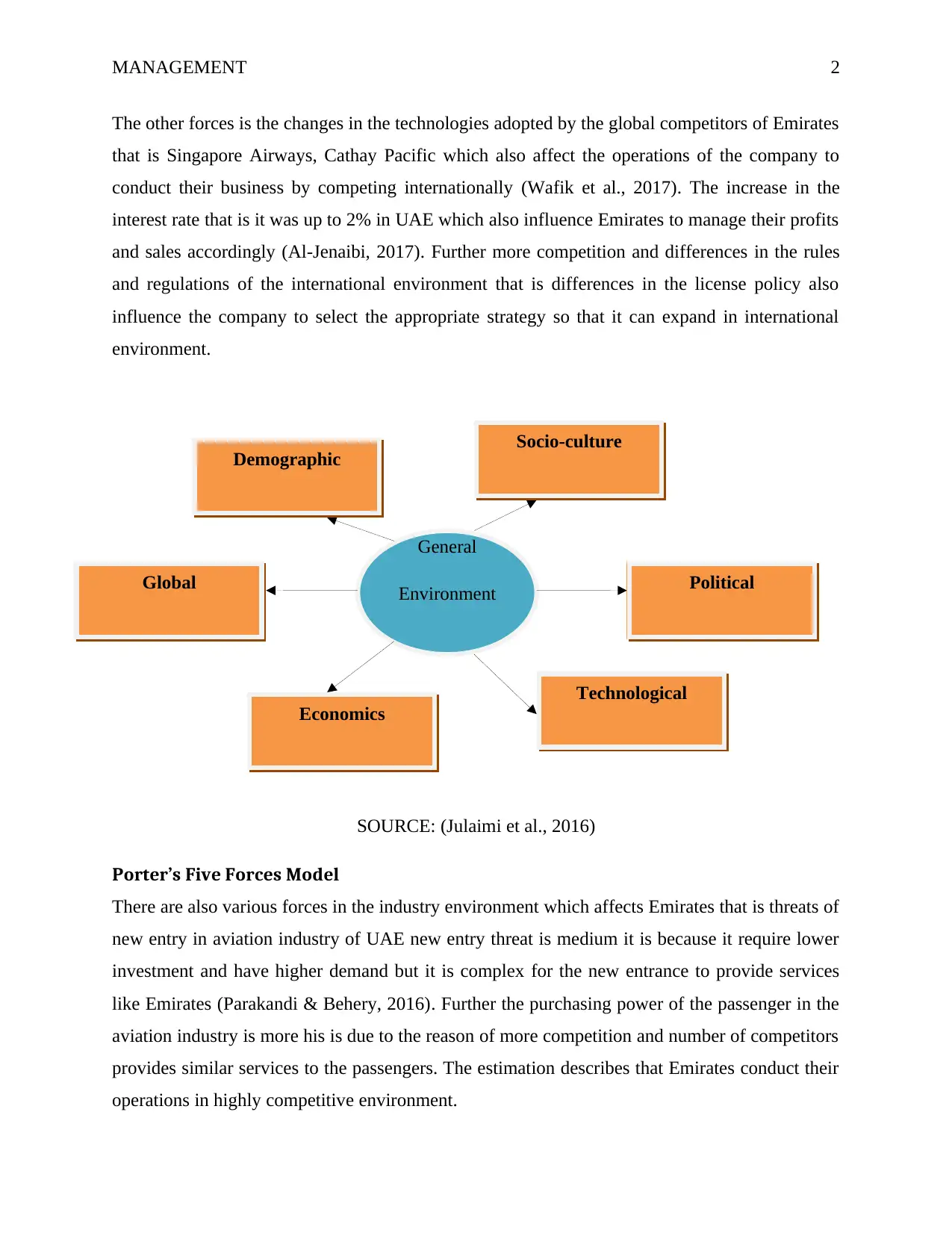
MANAGEMENT 2
The other forces is the changes in the technologies adopted by the global competitors of Emirates
that is Singapore Airways, Cathay Pacific which also affect the operations of the company to
conduct their business by competing internationally (Wafik et al., 2017). The increase in the
interest rate that is it was up to 2% in UAE which also influence Emirates to manage their profits
and sales accordingly (Al-Jenaibi, 2017). Further more competition and differences in the rules
and regulations of the international environment that is differences in the license policy also
influence the company to select the appropriate strategy so that it can expand in international
environment.
SOURCE: (Julaimi et al., 2016)
Porter’s Five Forces Model
There are also various forces in the industry environment which affects Emirates that is threats of
new entry in aviation industry of UAE new entry threat is medium it is because it require lower
investment and have higher demand but it is complex for the new entrance to provide services
like Emirates (Parakandi & Behery, 2016). Further the purchasing power of the passenger in the
aviation industry is more his is due to the reason of more competition and number of competitors
provides similar services to the passengers. The estimation describes that Emirates conduct their
operations in highly competitive environment.
General
Environment
Demographic Socio-culture
Political
Technological
Economics
Global
The other forces is the changes in the technologies adopted by the global competitors of Emirates
that is Singapore Airways, Cathay Pacific which also affect the operations of the company to
conduct their business by competing internationally (Wafik et al., 2017). The increase in the
interest rate that is it was up to 2% in UAE which also influence Emirates to manage their profits
and sales accordingly (Al-Jenaibi, 2017). Further more competition and differences in the rules
and regulations of the international environment that is differences in the license policy also
influence the company to select the appropriate strategy so that it can expand in international
environment.
SOURCE: (Julaimi et al., 2016)
Porter’s Five Forces Model
There are also various forces in the industry environment which affects Emirates that is threats of
new entry in aviation industry of UAE new entry threat is medium it is because it require lower
investment and have higher demand but it is complex for the new entrance to provide services
like Emirates (Parakandi & Behery, 2016). Further the purchasing power of the passenger in the
aviation industry is more his is due to the reason of more competition and number of competitors
provides similar services to the passengers. The estimation describes that Emirates conduct their
operations in highly competitive environment.
General
Environment
Demographic Socio-culture
Political
Technological
Economics
Global
⊘ This is a preview!⊘
Do you want full access?
Subscribe today to unlock all pages.

Trusted by 1+ million students worldwide
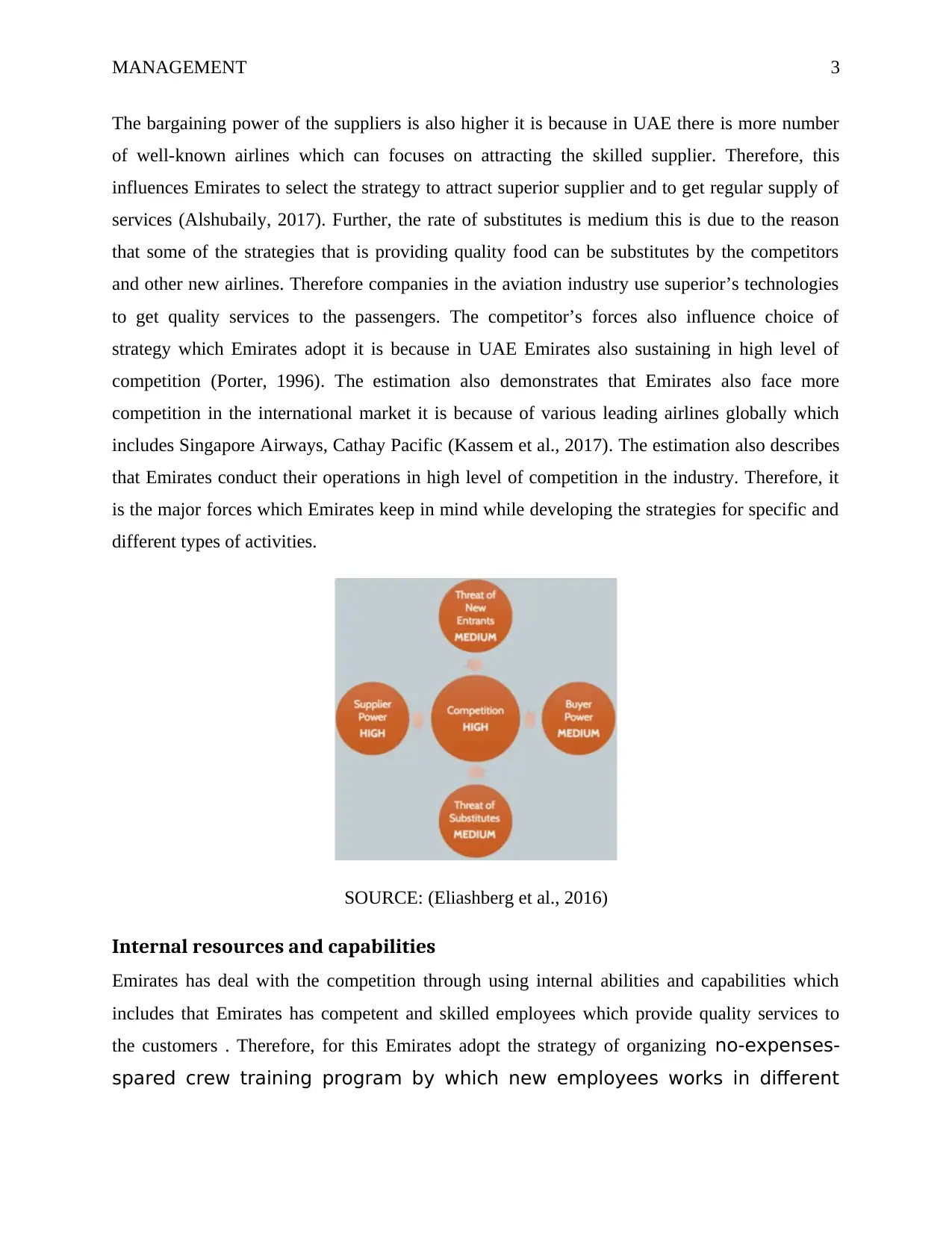
MANAGEMENT 3
The bargaining power of the suppliers is also higher it is because in UAE there is more number
of well-known airlines which can focuses on attracting the skilled supplier. Therefore, this
influences Emirates to select the strategy to attract superior supplier and to get regular supply of
services (Alshubaily, 2017). Further, the rate of substitutes is medium this is due to the reason
that some of the strategies that is providing quality food can be substitutes by the competitors
and other new airlines. Therefore companies in the aviation industry use superior’s technologies
to get quality services to the passengers. The competitor’s forces also influence choice of
strategy which Emirates adopt it is because in UAE Emirates also sustaining in high level of
competition (Porter, 1996). The estimation also demonstrates that Emirates also face more
competition in the international market it is because of various leading airlines globally which
includes Singapore Airways, Cathay Pacific (Kassem et al., 2017). The estimation also describes
that Emirates conduct their operations in high level of competition in the industry. Therefore, it
is the major forces which Emirates keep in mind while developing the strategies for specific and
different types of activities.
SOURCE: (Eliashberg et al., 2016)
Internal resources and capabilities
Emirates has deal with the competition through using internal abilities and capabilities which
includes that Emirates has competent and skilled employees which provide quality services to
the customers . Therefore, for this Emirates adopt the strategy of organizing no-expenses-
spared crew training program by which new employees works in different
The bargaining power of the suppliers is also higher it is because in UAE there is more number
of well-known airlines which can focuses on attracting the skilled supplier. Therefore, this
influences Emirates to select the strategy to attract superior supplier and to get regular supply of
services (Alshubaily, 2017). Further, the rate of substitutes is medium this is due to the reason
that some of the strategies that is providing quality food can be substitutes by the competitors
and other new airlines. Therefore companies in the aviation industry use superior’s technologies
to get quality services to the passengers. The competitor’s forces also influence choice of
strategy which Emirates adopt it is because in UAE Emirates also sustaining in high level of
competition (Porter, 1996). The estimation also demonstrates that Emirates also face more
competition in the international market it is because of various leading airlines globally which
includes Singapore Airways, Cathay Pacific (Kassem et al., 2017). The estimation also describes
that Emirates conduct their operations in high level of competition in the industry. Therefore, it
is the major forces which Emirates keep in mind while developing the strategies for specific and
different types of activities.
SOURCE: (Eliashberg et al., 2016)
Internal resources and capabilities
Emirates has deal with the competition through using internal abilities and capabilities which
includes that Emirates has competent and skilled employees which provide quality services to
the customers . Therefore, for this Emirates adopt the strategy of organizing no-expenses-
spared crew training program by which new employees works in different
Paraphrase This Document
Need a fresh take? Get an instant paraphrase of this document with our AI Paraphraser
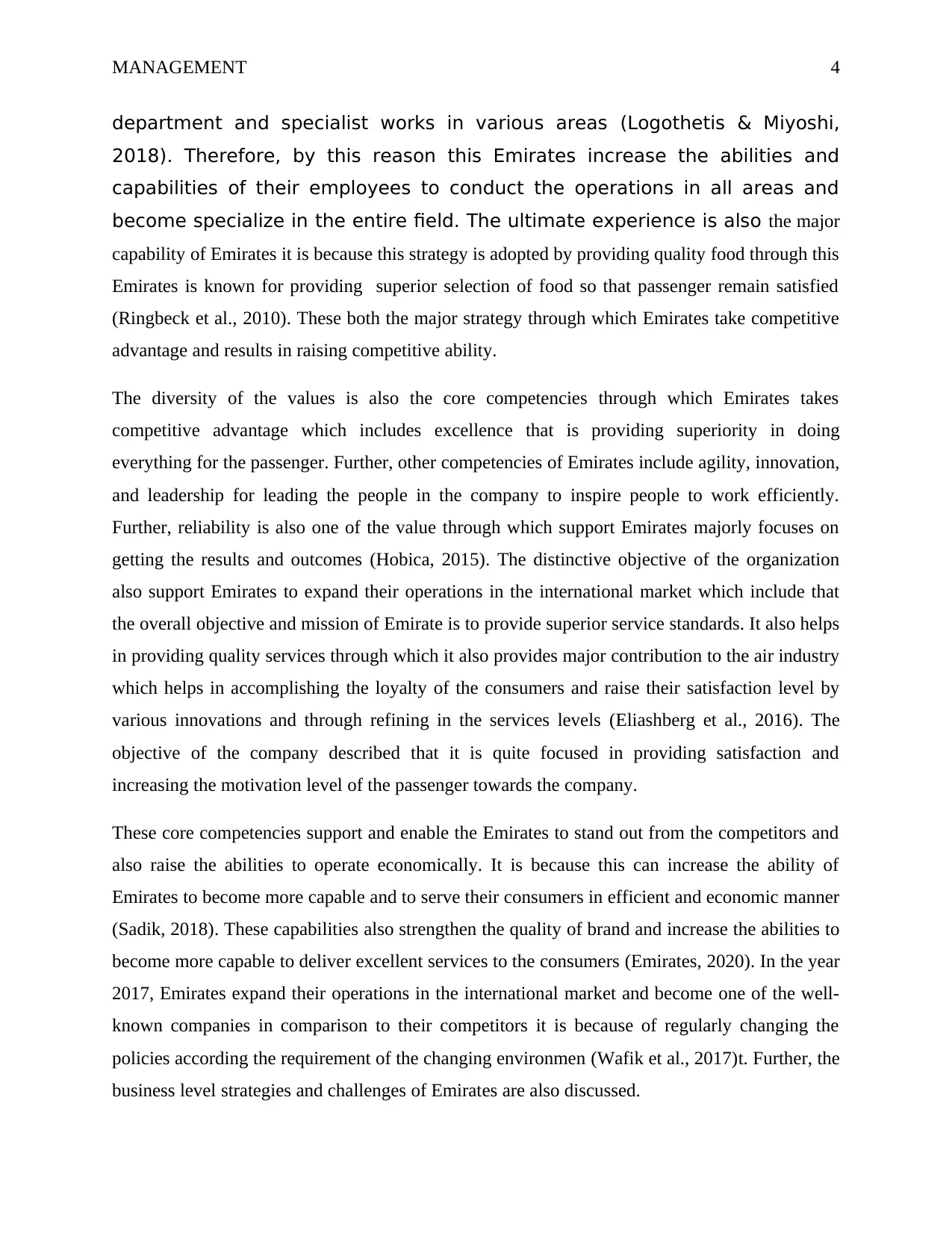
MANAGEMENT 4
department and specialist works in various areas (Logothetis & Miyoshi,
2018). Therefore, by this reason this Emirates increase the abilities and
capabilities of their employees to conduct the operations in all areas and
become specialize in the entire field. The ultimate experience is also the major
capability of Emirates it is because this strategy is adopted by providing quality food through this
Emirates is known for providing superior selection of food so that passenger remain satisfied
(Ringbeck et al., 2010). These both the major strategy through which Emirates take competitive
advantage and results in raising competitive ability.
The diversity of the values is also the core competencies through which Emirates takes
competitive advantage which includes excellence that is providing superiority in doing
everything for the passenger. Further, other competencies of Emirates include agility, innovation,
and leadership for leading the people in the company to inspire people to work efficiently.
Further, reliability is also one of the value through which support Emirates majorly focuses on
getting the results and outcomes (Hobica, 2015). The distinctive objective of the organization
also support Emirates to expand their operations in the international market which include that
the overall objective and mission of Emirate is to provide superior service standards. It also helps
in providing quality services through which it also provides major contribution to the air industry
which helps in accomplishing the loyalty of the consumers and raise their satisfaction level by
various innovations and through refining in the services levels (Eliashberg et al., 2016). The
objective of the company described that it is quite focused in providing satisfaction and
increasing the motivation level of the passenger towards the company.
These core competencies support and enable the Emirates to stand out from the competitors and
also raise the abilities to operate economically. It is because this can increase the ability of
Emirates to become more capable and to serve their consumers in efficient and economic manner
(Sadik, 2018). These capabilities also strengthen the quality of brand and increase the abilities to
become more capable to deliver excellent services to the consumers (Emirates, 2020). In the year
2017, Emirates expand their operations in the international market and become one of the well-
known companies in comparison to their competitors it is because of regularly changing the
policies according the requirement of the changing environmen (Wafik et al., 2017)t. Further, the
business level strategies and challenges of Emirates are also discussed.
department and specialist works in various areas (Logothetis & Miyoshi,
2018). Therefore, by this reason this Emirates increase the abilities and
capabilities of their employees to conduct the operations in all areas and
become specialize in the entire field. The ultimate experience is also the major
capability of Emirates it is because this strategy is adopted by providing quality food through this
Emirates is known for providing superior selection of food so that passenger remain satisfied
(Ringbeck et al., 2010). These both the major strategy through which Emirates take competitive
advantage and results in raising competitive ability.
The diversity of the values is also the core competencies through which Emirates takes
competitive advantage which includes excellence that is providing superiority in doing
everything for the passenger. Further, other competencies of Emirates include agility, innovation,
and leadership for leading the people in the company to inspire people to work efficiently.
Further, reliability is also one of the value through which support Emirates majorly focuses on
getting the results and outcomes (Hobica, 2015). The distinctive objective of the organization
also support Emirates to expand their operations in the international market which include that
the overall objective and mission of Emirate is to provide superior service standards. It also helps
in providing quality services through which it also provides major contribution to the air industry
which helps in accomplishing the loyalty of the consumers and raise their satisfaction level by
various innovations and through refining in the services levels (Eliashberg et al., 2016). The
objective of the company described that it is quite focused in providing satisfaction and
increasing the motivation level of the passenger towards the company.
These core competencies support and enable the Emirates to stand out from the competitors and
also raise the abilities to operate economically. It is because this can increase the ability of
Emirates to become more capable and to serve their consumers in efficient and economic manner
(Sadik, 2018). These capabilities also strengthen the quality of brand and increase the abilities to
become more capable to deliver excellent services to the consumers (Emirates, 2020). In the year
2017, Emirates expand their operations in the international market and become one of the well-
known companies in comparison to their competitors it is because of regularly changing the
policies according the requirement of the changing environmen (Wafik et al., 2017)t. Further, the
business level strategies and challenges of Emirates are also discussed.
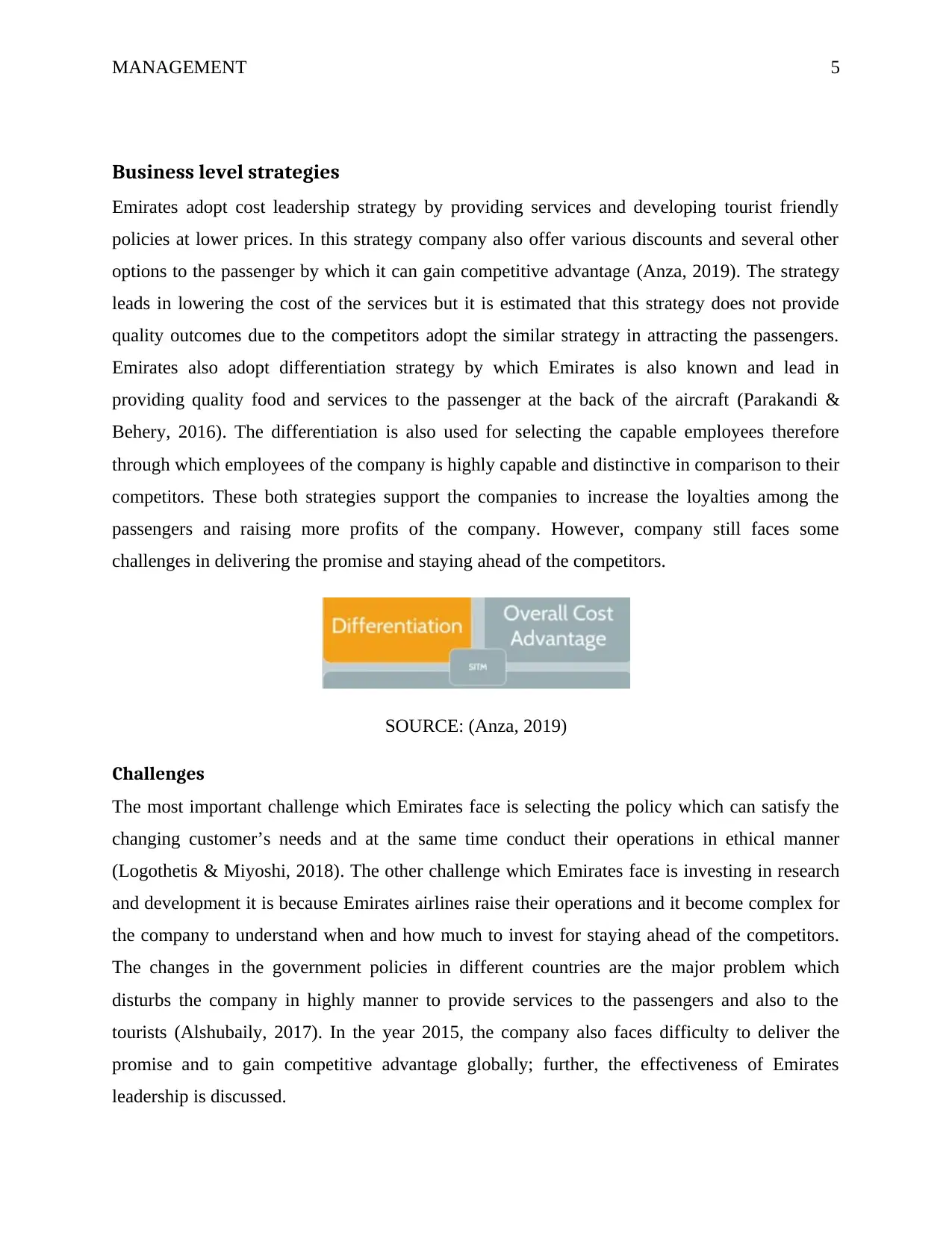
MANAGEMENT 5
Business level strategies
Emirates adopt cost leadership strategy by providing services and developing tourist friendly
policies at lower prices. In this strategy company also offer various discounts and several other
options to the passenger by which it can gain competitive advantage (Anza, 2019). The strategy
leads in lowering the cost of the services but it is estimated that this strategy does not provide
quality outcomes due to the competitors adopt the similar strategy in attracting the passengers.
Emirates also adopt differentiation strategy by which Emirates is also known and lead in
providing quality food and services to the passenger at the back of the aircraft (Parakandi &
Behery, 2016). The differentiation is also used for selecting the capable employees therefore
through which employees of the company is highly capable and distinctive in comparison to their
competitors. These both strategies support the companies to increase the loyalties among the
passengers and raising more profits of the company. However, company still faces some
challenges in delivering the promise and staying ahead of the competitors.
SOURCE: (Anza, 2019)
Challenges
The most important challenge which Emirates face is selecting the policy which can satisfy the
changing customer’s needs and at the same time conduct their operations in ethical manner
(Logothetis & Miyoshi, 2018). The other challenge which Emirates face is investing in research
and development it is because Emirates airlines raise their operations and it become complex for
the company to understand when and how much to invest for staying ahead of the competitors.
The changes in the government policies in different countries are the major problem which
disturbs the company in highly manner to provide services to the passengers and also to the
tourists (Alshubaily, 2017). In the year 2015, the company also faces difficulty to deliver the
promise and to gain competitive advantage globally; further, the effectiveness of Emirates
leadership is discussed.
Business level strategies
Emirates adopt cost leadership strategy by providing services and developing tourist friendly
policies at lower prices. In this strategy company also offer various discounts and several other
options to the passenger by which it can gain competitive advantage (Anza, 2019). The strategy
leads in lowering the cost of the services but it is estimated that this strategy does not provide
quality outcomes due to the competitors adopt the similar strategy in attracting the passengers.
Emirates also adopt differentiation strategy by which Emirates is also known and lead in
providing quality food and services to the passenger at the back of the aircraft (Parakandi &
Behery, 2016). The differentiation is also used for selecting the capable employees therefore
through which employees of the company is highly capable and distinctive in comparison to their
competitors. These both strategies support the companies to increase the loyalties among the
passengers and raising more profits of the company. However, company still faces some
challenges in delivering the promise and staying ahead of the competitors.
SOURCE: (Anza, 2019)
Challenges
The most important challenge which Emirates face is selecting the policy which can satisfy the
changing customer’s needs and at the same time conduct their operations in ethical manner
(Logothetis & Miyoshi, 2018). The other challenge which Emirates face is investing in research
and development it is because Emirates airlines raise their operations and it become complex for
the company to understand when and how much to invest for staying ahead of the competitors.
The changes in the government policies in different countries are the major problem which
disturbs the company in highly manner to provide services to the passengers and also to the
tourists (Alshubaily, 2017). In the year 2015, the company also faces difficulty to deliver the
promise and to gain competitive advantage globally; further, the effectiveness of Emirates
leadership is discussed.
⊘ This is a preview!⊘
Do you want full access?
Subscribe today to unlock all pages.

Trusted by 1+ million students worldwide
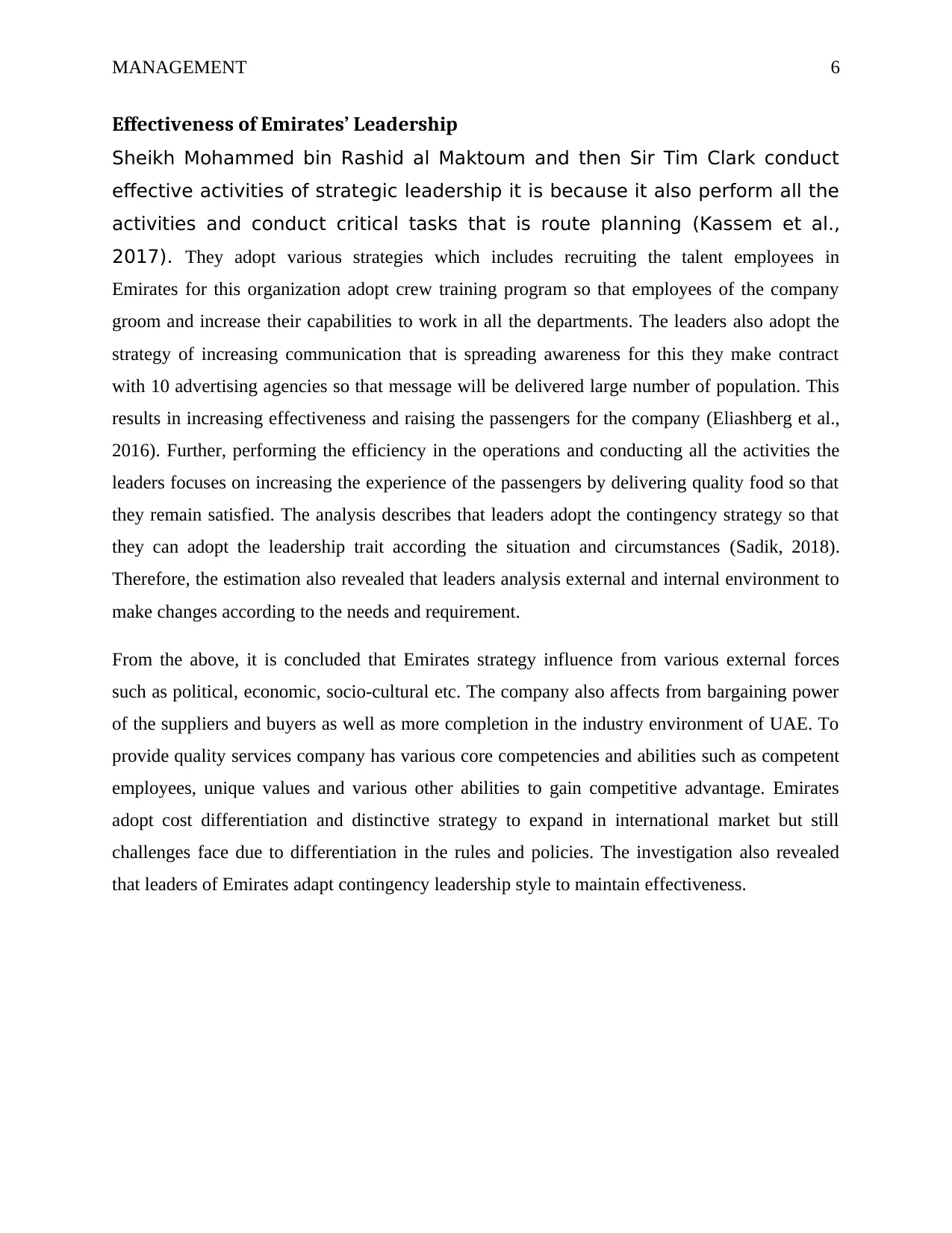
MANAGEMENT 6
Effectiveness of Emirates’ Leadership
Sheikh Mohammed bin Rashid al Maktoum and then Sir Tim Clark conduct
effective activities of strategic leadership it is because it also perform all the
activities and conduct critical tasks that is route planning (Kassem et al.,
2017). They adopt various strategies which includes recruiting the talent employees in
Emirates for this organization adopt crew training program so that employees of the company
groom and increase their capabilities to work in all the departments. The leaders also adopt the
strategy of increasing communication that is spreading awareness for this they make contract
with 10 advertising agencies so that message will be delivered large number of population. This
results in increasing effectiveness and raising the passengers for the company (Eliashberg et al.,
2016). Further, performing the efficiency in the operations and conducting all the activities the
leaders focuses on increasing the experience of the passengers by delivering quality food so that
they remain satisfied. The analysis describes that leaders adopt the contingency strategy so that
they can adopt the leadership trait according the situation and circumstances (Sadik, 2018).
Therefore, the estimation also revealed that leaders analysis external and internal environment to
make changes according to the needs and requirement.
From the above, it is concluded that Emirates strategy influence from various external forces
such as political, economic, socio-cultural etc. The company also affects from bargaining power
of the suppliers and buyers as well as more completion in the industry environment of UAE. To
provide quality services company has various core competencies and abilities such as competent
employees, unique values and various other abilities to gain competitive advantage. Emirates
adopt cost differentiation and distinctive strategy to expand in international market but still
challenges face due to differentiation in the rules and policies. The investigation also revealed
that leaders of Emirates adapt contingency leadership style to maintain effectiveness.
Effectiveness of Emirates’ Leadership
Sheikh Mohammed bin Rashid al Maktoum and then Sir Tim Clark conduct
effective activities of strategic leadership it is because it also perform all the
activities and conduct critical tasks that is route planning (Kassem et al.,
2017). They adopt various strategies which includes recruiting the talent employees in
Emirates for this organization adopt crew training program so that employees of the company
groom and increase their capabilities to work in all the departments. The leaders also adopt the
strategy of increasing communication that is spreading awareness for this they make contract
with 10 advertising agencies so that message will be delivered large number of population. This
results in increasing effectiveness and raising the passengers for the company (Eliashberg et al.,
2016). Further, performing the efficiency in the operations and conducting all the activities the
leaders focuses on increasing the experience of the passengers by delivering quality food so that
they remain satisfied. The analysis describes that leaders adopt the contingency strategy so that
they can adopt the leadership trait according the situation and circumstances (Sadik, 2018).
Therefore, the estimation also revealed that leaders analysis external and internal environment to
make changes according to the needs and requirement.
From the above, it is concluded that Emirates strategy influence from various external forces
such as political, economic, socio-cultural etc. The company also affects from bargaining power
of the suppliers and buyers as well as more completion in the industry environment of UAE. To
provide quality services company has various core competencies and abilities such as competent
employees, unique values and various other abilities to gain competitive advantage. Emirates
adopt cost differentiation and distinctive strategy to expand in international market but still
challenges face due to differentiation in the rules and policies. The investigation also revealed
that leaders of Emirates adapt contingency leadership style to maintain effectiveness.
Paraphrase This Document
Need a fresh take? Get an instant paraphrase of this document with our AI Paraphraser
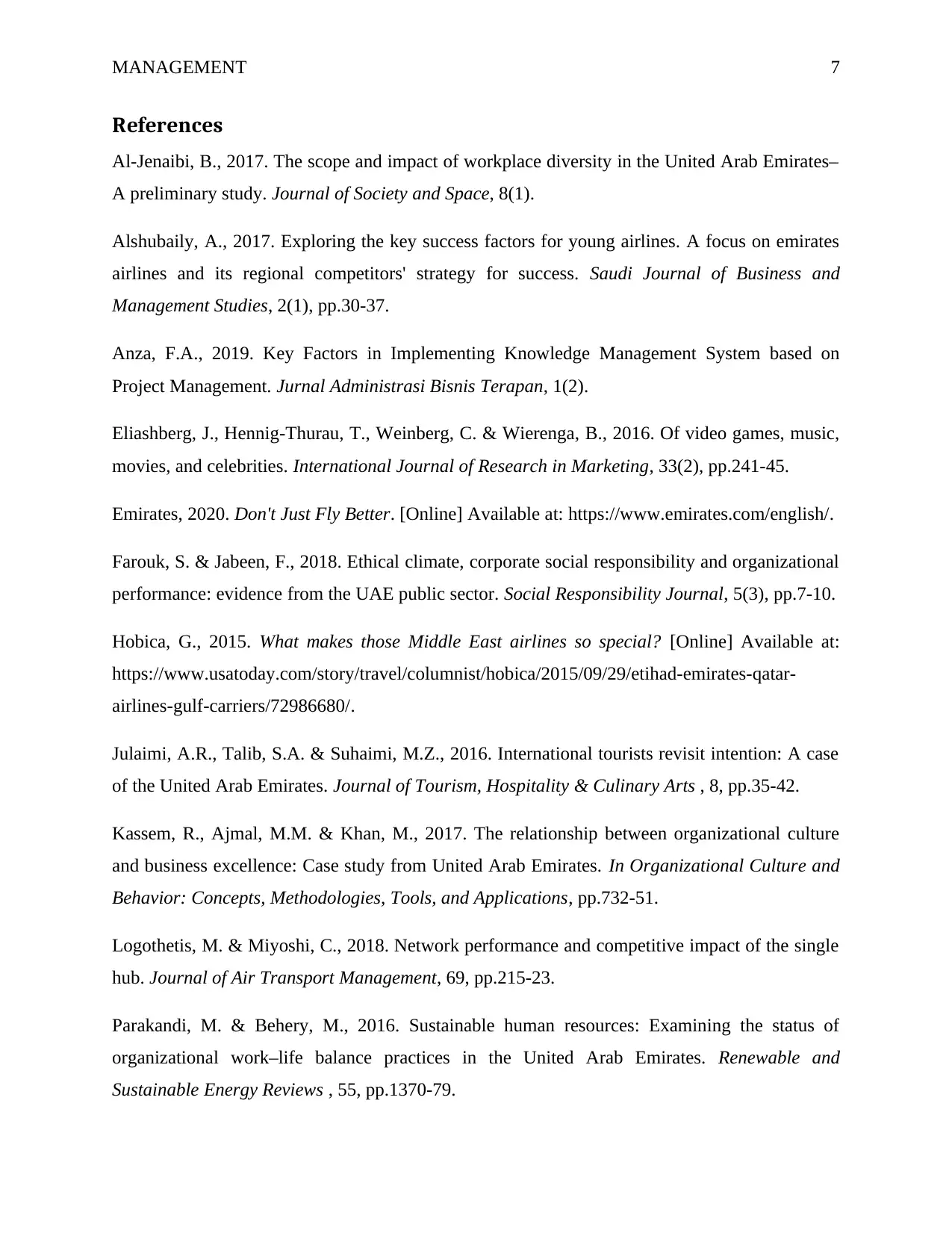
MANAGEMENT 7
References
Al-Jenaibi, B., 2017. The scope and impact of workplace diversity in the United Arab Emirates–
A preliminary study. Journal of Society and Space, 8(1).
Alshubaily, A., 2017. Exploring the key success factors for young airlines. A focus on emirates
airlines and its regional competitors' strategy for success. Saudi Journal of Business and
Management Studies, 2(1), pp.30-37.
Anza, F.A., 2019. Key Factors in Implementing Knowledge Management System based on
Project Management. Jurnal Administrasi Bisnis Terapan, 1(2).
Eliashberg, J., Hennig-Thurau, T., Weinberg, C. & Wierenga, B., 2016. Of video games, music,
movies, and celebrities. International Journal of Research in Marketing, 33(2), pp.241-45.
Emirates, 2020. Don't Just Fly Better. [Online] Available at: https://www.emirates.com/english/.
Farouk, S. & Jabeen, F., 2018. Ethical climate, corporate social responsibility and organizational
performance: evidence from the UAE public sector. Social Responsibility Journal, 5(3), pp.7-10.
Hobica, G., 2015. What makes those Middle East airlines so special? [Online] Available at:
https://www.usatoday.com/story/travel/columnist/hobica/2015/09/29/etihad-emirates-qatar-
airlines-gulf-carriers/72986680/.
Julaimi, A.R., Talib, S.A. & Suhaimi, M.Z., 2016. International tourists revisit intention: A case
of the United Arab Emirates. Journal of Tourism, Hospitality & Culinary Arts , 8, pp.35-42.
Kassem, R., Ajmal, M.M. & Khan, M., 2017. The relationship between organizational culture
and business excellence: Case study from United Arab Emirates. In Organizational Culture and
Behavior: Concepts, Methodologies, Tools, and Applications, pp.732-51.
Logothetis, M. & Miyoshi, C., 2018. Network performance and competitive impact of the single
hub. Journal of Air Transport Management, 69, pp.215-23.
Parakandi, M. & Behery, M., 2016. Sustainable human resources: Examining the status of
organizational work–life balance practices in the United Arab Emirates. Renewable and
Sustainable Energy Reviews , 55, pp.1370-79.
References
Al-Jenaibi, B., 2017. The scope and impact of workplace diversity in the United Arab Emirates–
A preliminary study. Journal of Society and Space, 8(1).
Alshubaily, A., 2017. Exploring the key success factors for young airlines. A focus on emirates
airlines and its regional competitors' strategy for success. Saudi Journal of Business and
Management Studies, 2(1), pp.30-37.
Anza, F.A., 2019. Key Factors in Implementing Knowledge Management System based on
Project Management. Jurnal Administrasi Bisnis Terapan, 1(2).
Eliashberg, J., Hennig-Thurau, T., Weinberg, C. & Wierenga, B., 2016. Of video games, music,
movies, and celebrities. International Journal of Research in Marketing, 33(2), pp.241-45.
Emirates, 2020. Don't Just Fly Better. [Online] Available at: https://www.emirates.com/english/.
Farouk, S. & Jabeen, F., 2018. Ethical climate, corporate social responsibility and organizational
performance: evidence from the UAE public sector. Social Responsibility Journal, 5(3), pp.7-10.
Hobica, G., 2015. What makes those Middle East airlines so special? [Online] Available at:
https://www.usatoday.com/story/travel/columnist/hobica/2015/09/29/etihad-emirates-qatar-
airlines-gulf-carriers/72986680/.
Julaimi, A.R., Talib, S.A. & Suhaimi, M.Z., 2016. International tourists revisit intention: A case
of the United Arab Emirates. Journal of Tourism, Hospitality & Culinary Arts , 8, pp.35-42.
Kassem, R., Ajmal, M.M. & Khan, M., 2017. The relationship between organizational culture
and business excellence: Case study from United Arab Emirates. In Organizational Culture and
Behavior: Concepts, Methodologies, Tools, and Applications, pp.732-51.
Logothetis, M. & Miyoshi, C., 2018. Network performance and competitive impact of the single
hub. Journal of Air Transport Management, 69, pp.215-23.
Parakandi, M. & Behery, M., 2016. Sustainable human resources: Examining the status of
organizational work–life balance practices in the United Arab Emirates. Renewable and
Sustainable Energy Reviews , 55, pp.1370-79.
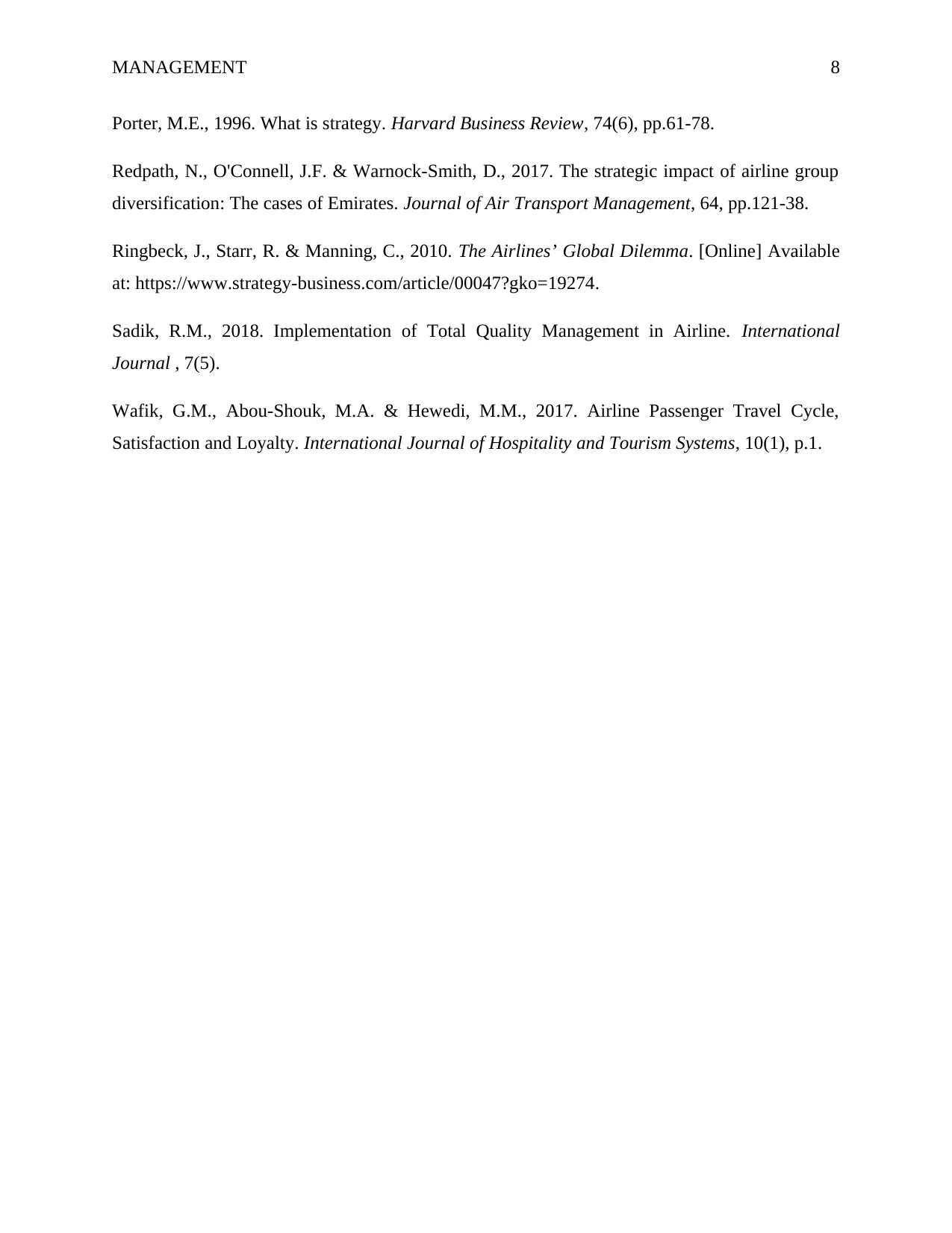
MANAGEMENT 8
Porter, M.E., 1996. What is strategy. Harvard Business Review, 74(6), pp.61-78.
Redpath, N., O'Connell, J.F. & Warnock-Smith, D., 2017. The strategic impact of airline group
diversification: The cases of Emirates. Journal of Air Transport Management, 64, pp.121-38.
Ringbeck, J., Starr, R. & Manning, C., 2010. The Airlines’ Global Dilemma. [Online] Available
at: https://www.strategy-business.com/article/00047?gko=19274.
Sadik, R.M., 2018. Implementation of Total Quality Management in Airline. International
Journal , 7(5).
Wafik, G.M., Abou-Shouk, M.A. & Hewedi, M.M., 2017. Airline Passenger Travel Cycle,
Satisfaction and Loyalty. International Journal of Hospitality and Tourism Systems, 10(1), p.1.
Porter, M.E., 1996. What is strategy. Harvard Business Review, 74(6), pp.61-78.
Redpath, N., O'Connell, J.F. & Warnock-Smith, D., 2017. The strategic impact of airline group
diversification: The cases of Emirates. Journal of Air Transport Management, 64, pp.121-38.
Ringbeck, J., Starr, R. & Manning, C., 2010. The Airlines’ Global Dilemma. [Online] Available
at: https://www.strategy-business.com/article/00047?gko=19274.
Sadik, R.M., 2018. Implementation of Total Quality Management in Airline. International
Journal , 7(5).
Wafik, G.M., Abou-Shouk, M.A. & Hewedi, M.M., 2017. Airline Passenger Travel Cycle,
Satisfaction and Loyalty. International Journal of Hospitality and Tourism Systems, 10(1), p.1.
⊘ This is a preview!⊘
Do you want full access?
Subscribe today to unlock all pages.

Trusted by 1+ million students worldwide
1 out of 9
Related Documents
Your All-in-One AI-Powered Toolkit for Academic Success.
+13062052269
info@desklib.com
Available 24*7 on WhatsApp / Email
![[object Object]](/_next/static/media/star-bottom.7253800d.svg)
Unlock your academic potential
Copyright © 2020–2025 A2Z Services. All Rights Reserved. Developed and managed by ZUCOL.





